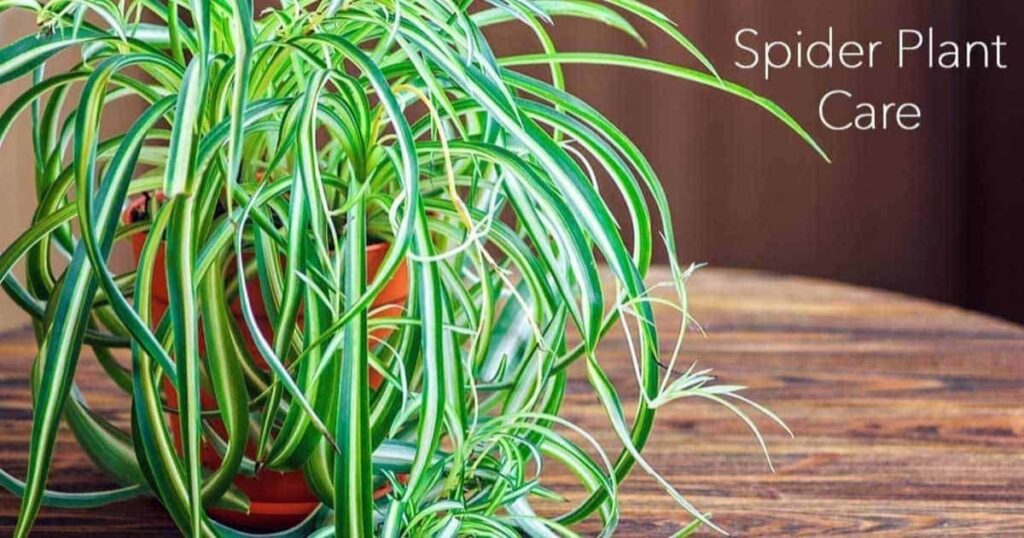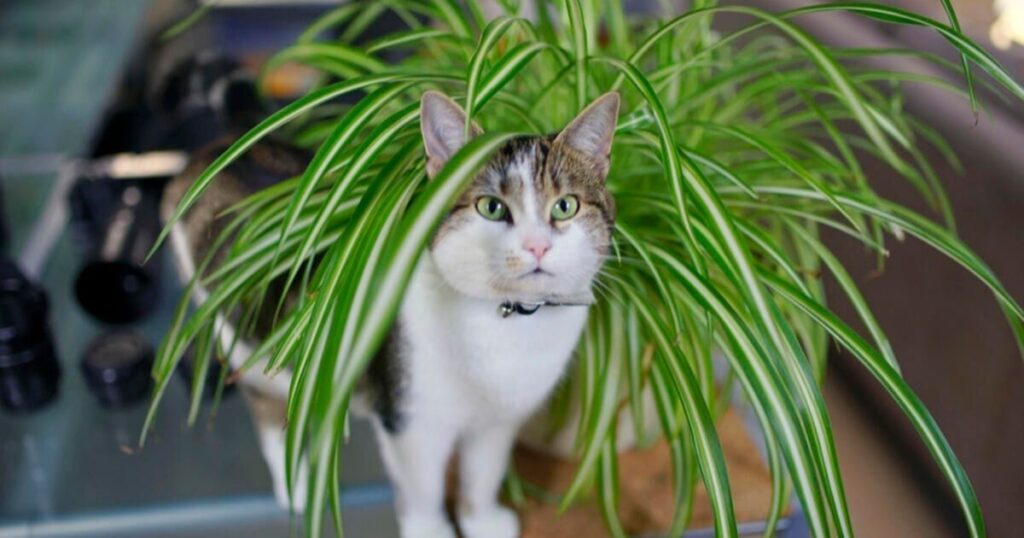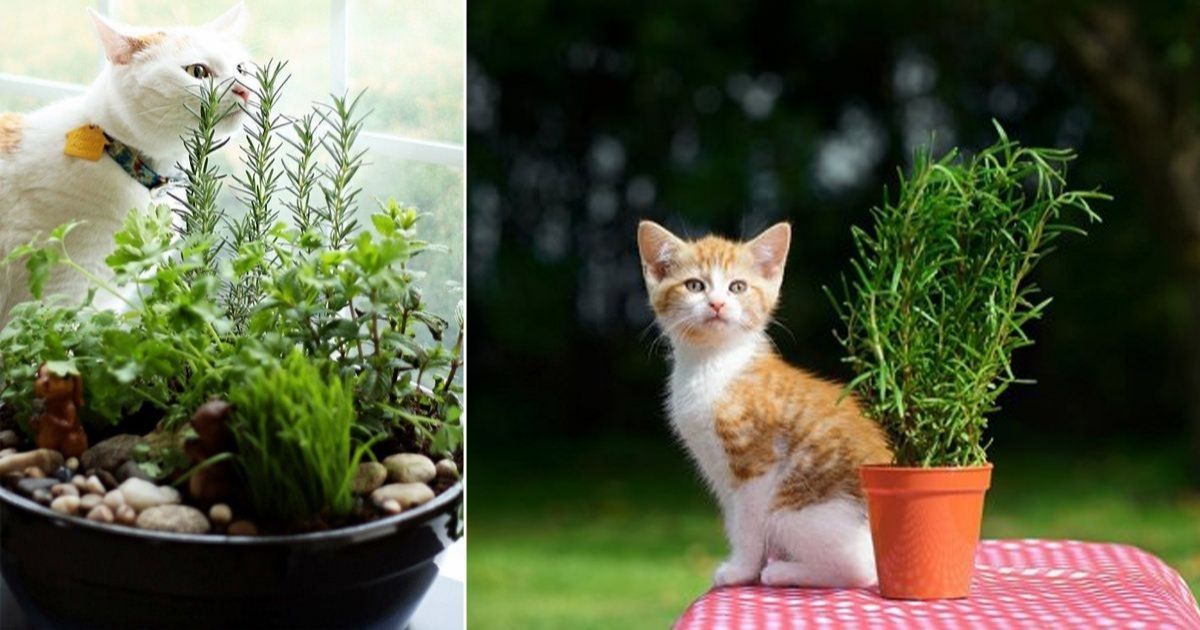Nontoxic, But Still Upsetting
Spider plants (Chlorophytum comosum) are a common houseplant known for their attractive arching leaves and easy care requirements. While they are generally considered non-toxic to cats, ingesting spider plant leaves can still be upsetting for your feline friend. These plants contain chemical compounds that can cause vomiting, diarrhea, and other digestive issues in cats.
Why Do Cats Like Spider Plants?
Cats are naturally curious creatures, and many are attracted to the dangling, grass-like leaves of spider plants. Some cats may simply enjoy the texture or taste of the leaves, while others may be drawn to the movement of the plant’s long stems. Additionally, cats are obligate carnivores and may chew on plants as a way to supplement their diet with additional nutrients or fiber.
How to Prevent Your Cat From Eating Your Spider Plant
While spider plants are not poisonous to cats, it’s still best to discourage your feline friend from ingesting them. Eating too much of the plant can lead to gastrointestinal upset, and some cats may even develop an allergic reaction. To keep your cat safe and your spider plant healthy, there are several steps you can take to protect both.
What You’ll Learn
In this article, we’ll explore the safety of spider plants for cats, why our feline friends are attracted to these plants, and practical tips to help you keep your cat away from your spider plant. We’ll also dispel some common myths surrounding spider plant toxicity and provide valuable insights into creating a harmonious coexistence between your indoor plants and furry companions.
Also read this post: The Garden of Eden
Spider Plant Safety

While spider plants are generally considered non-toxic to cats, they can still cause digestive upset if ingested in large quantities. The plant contains chemical compounds called saponins, which can irritate the gastrointestinal tract and lead to vomiting, diarrhea, and abdominal discomfort in cats.
It’s important to note that while the plant itself is not poisonous, some cats may develop an allergic reaction to it, which can result in symptoms like excessive drooling, difficulty swallowing, or even respiratory distress. If you notice any of these signs after your cat has ingested a spider plant, it’s best to contact your veterinarian immediately.
Why Cats Like Spider Plants
There are a few reasons why cats may be attracted to spider plants:
- Texture and movement: Cats are naturally drawn to the dangling, grass-like leaves of spider plants. The movement of the plant’s long stems can trigger their hunting instincts, making them want to play or chew on the leaves.
- Taste: Some cats may simply enjoy the taste or texture of the spider plant’s leaves, which can be a tempting snack for our feline friends.
- Nutritional supplementation: As obligate carnivores, cats may chew on plants like spider plants to supplement their diet with additional nutrients or fiber.
- Boredom or curiosity: Cats are inquisitive creatures, and a spider plant’s unique appearance and movement may pique their interest, leading them to investigate and potentially nibble on the plant.
Protecting Your Plant
To keep your cat safe and your spider plant healthy, it’s essential to take proactive measures to discourage your feline friend from ingesting the plant. Here are some effective strategies:
- Provide cat grass or catnip: Offer your cat an alternative plant that is safe for them to chew on, such as cat grass or catnip. These plants are designed specifically for feline consumption and can help satisfy their urge to nibble on greenery.
- Use deterrents: Apply deterrents like citrus or vinegar sprays around the base of your spider plant. Cats generally dislike the strong scents of citrus and vinegar, which can help discourage them from approaching the plant.
- Secure the plant: Place your spider plant in a hanging basket or on a high shelf, making it inaccessible to your cat. Alternatively, you can use a clear plastic or glass terrarium or a domed birdcage to protect the plant while still allowing it to be displayed.
- Distract and redirect: Provide your cat with plenty of toys, scratching posts, and other enrichment activities to keep them entertained and distracted from the spider plant.
- Supervision and training: Whenever possible, supervise your cat’s interactions with the spider plant and use positive reinforcement to discourage unwanted behavior. With patience and consistency, you can train your cat to leave the plant alone.
Spider Plants and Cats

While spider plants are generally considered non-toxic to cats, ingesting large amounts of the plant can still cause gastrointestinal upset and potentially trigger allergic reactions in some felines. To ensure a harmonious coexistence between your indoor plants and furry companions, it’s crucial to take preventative measures and provide safe alternatives for your cat’s natural chewing and grazing behaviors.
Spider Plant Toxicity
Despite being labeled as non-toxic, spider plants contain chemical compounds called saponins that can irritate a cat’s digestive system if consumed in large quantities. While not life-threatening, ingesting spider plant leaves can lead to vomiting, diarrhea, and abdominal discomfort in cats.
It’s important to note that some cats may also develop an allergic reaction to spider plants, which can result in excessive drooling, difficulty swallowing, or even respiratory distress. If you notice any of these symptoms after your cat has ingested a spider plant, it’s best to contact your veterinarian immediately.
Spider Plants: A Threat To Cats – Myth Or Truth
There are several myths surrounding the safety of spider plants for cats. Some sources claim that these plants are highly toxic and can cause severe illness or even death in felines. However, this is not entirely accurate.
While spider plants are not considered poisonous to cats, they can still cause digestive upset and potential allergic reactions in some cases. It’s essential to separate fact from fiction and understand the actual risks associated with these popular houseplants.
Why Do Cats Like Spider Plants?
Cats are naturally curious creatures, and many are attracted to the unique appearance and movement of spider plants. The dangling, grass-like leaves can trigger their hunting instincts, making them want to play or chew on the plant. Additionally, some cats may be drawn to the taste or texture of the spider plant’s leaves, while others may chew on them as a way to supplement their diet with additional nutrients or fiber.
Making Spider Plants and Cats Coexist: Tips and Tricks
While spider plants are not necessarily toxic to cats, it’s still best to discourage your feline friend from ingesting them. Here are some practical tips and tricks to help you create a harmonious coexistence between your indoor plants and furry companions:
1) Spicy Sprinkles and Citrus Spray
Cats generally dislike strong, pungent smells. You can sprinkle cayenne pepper or chili powder around the base of your spider plant, or make a citrus spray by mixing water with lemon or orange peels. The unpleasant scents can deter your cat from approaching or nibbling on the plant.
2) Citrus Fruit Rinds as Natural Shields
Another way to leverage cats’ dislike for citrus scents is by placing citrus fruit rinds around the base of your spider plant. The strong aroma can act as a natural barrier, discouraging your cat from getting too close to the plant.
3) Making It Inaccessible and Distracting
Place your spider plant in a hanging basket or on a high shelf, making it inaccessible to your cat. Alternatively, provide your cat with plenty of toys, scratching posts, and other enrichment activities to keep them entertained and distracted from the plant.
4) Terrariums or Domed Birdcages
Consider placing your spider plant in a clear plastic or glass terrarium or a domed birdcage. This not only protects the plant from your cat but also allows you to display it while keeping it out of reach.
5) Clean Litter Box, Happy Cat
Cats are often drawn to plants as a way to supplement their diet with additional fiber. Ensure that your cat’s litter box is kept clean and fresh, as this can reduce their urge to seek out alternative sources of fiber, such as your spider plant.
Gardening tips, videos, info, and more are delivered right to your inbox!
To stay updated on the latest gardening tips, plant care advice, and indoor gardening trends, consider subscribing to our newsletter. We’ll deliver valuable information, videos, and insights directly to your inbox, helping you cultivate a thriving indoor garden while keeping your furry friends safe and happy.
Keeping Cats from Spider Plants

While spider plants are generally considered non-toxic to cats, it’s still important to take precautions to prevent your feline friend from ingesting the plant. Here are some additional tips to help keep your cat away from your spider plant:
- Use deterrents: In addition to citrus and spicy deterrents, you can also try using deterrent sprays specifically designed for cats. These sprays often contain natural ingredients like essential oils that are unpleasant to cats but safe for both them and your plants.
- Provide alternative plants: Offer your cat safe, cat-friendly plants to nibble on, such as cat grass or wheatgrass. These plants are specifically grown for cats and can help satisfy their urge to chew without risking exposure to potentially harmful plants.
- Train and redirect: Consistently redirect your cat’s attention away from the spider plant and provide positive reinforcement when they engage with appropriate toys or scratching posts. With patience and consistency, you can train your cat to leave the plant alone.
- Rotate plant locations: Periodically move your spider plant to different locations, as cats may lose interest in a plant they’ve become accustomed to in a specific spot.
- Use physical barriers: If deterrents and training aren’t effective, consider placing a physical barrier around your spider plant, such as a decorative trellis or wire mesh. This can prevent your cat from accessing the plant while still allowing it to receive adequate light and ventilation.
- Monitor your cat: Whenever possible, supervise your cat’s interactions with the spider plant and intervene if necessary. This can help reinforce positive behaviors and prevent any potential incidents of ingestion.
By implementing a combination of these strategies, you can help protect both your cat and your beloved spider plant. Remember, while spider plants are generally considered safe for cats, it’s always better to err on the side of caution and take proactive measures to discourage your feline friend from ingesting any part of the plant.
FAQs:
What happens if your cat eats spider plants?
If a cat ingests a small amount of spider plant, it may experience mild gastrointestinal upset like vomiting or diarrhea. However, if a large quantity is consumed, it can potentially cause more severe symptoms like excessive drooling, difficulty swallowing, or even an allergic reaction.
Are spider plants pet-safe?
Spider plants are generally considered non-toxic and safe for pets, but they can still cause digestive issues or allergic reactions in some cats and dogs if ingested. While not poisonous, it’s best to discourage pets from eating spider plants to avoid any potential health problems.
Is it okay if my cat eats spiders?
No, it’s not recommended for cats to eat spiders as some species can be harmful or even venomous. While cats may instinctively hunt and consume small insects and arachnids, ingesting spiders can potentially cause digestive problems, allergic reactions, or even toxicity in some cases.
Do spider plants clean the air?
Yes, spider plants are known for their ability to purify indoor air by removing harmful pollutants like formaldehyde, xylene, and toluene. They are commonly recommended as one of the best air-purifying plants to have in homes and offices due to their effectiveness in improving air quality.











